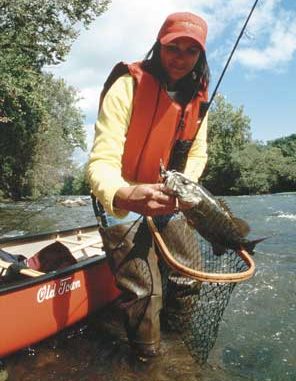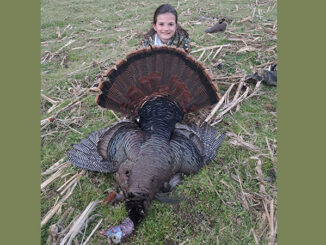
Avoid October’s wall-to-wall tourists by combining colorful scenery and great smallmouth fishing at the French Broad River.
Travis Honeycutt maneuvered the boat through the shallow riffle and anchored about 10 yards below the fast water.
“Let’s work these deep pools on either side of the boat,” he said.
After a couple of cast of the soft crawfish bait, an angler recognized the light tension of his line meant a fish had taken the lure.
The fish knew this terrain and managed to wrap the line around an underwater snag. The water was low and clear enough for Honeycutt to see the smallmouth bass.
“It’s a nice one, maybe 2 pounds,” he said.
About that time, the line went slack as the bass used the snag to free itself.
Losing a fish at a snag is a familiar scenario, but this fishing trip wasn’t typical. October is a time when most outdoorsmen’s thoughts turn to bow season for deer, early-season grouse or squirrel hunting. But this trip occurred during an October float-fishing excursion when the world becomes a mosaic of autumn colors lining the cool, clear waters of the French Broad River.
Each October thousands of people flock to the mountains of western North Carolina to enjoy the crisp air and splendid colors of yellow poplar and red maple leaves that cover the ridge lines. They visit craft fairs and drive the Blue Ridge Parkway literally to soak in the local color. Most overlook the excellent fall fishing at nearby rivers and streams.
While most attention is focused on fly fishing delayed-harvest trout waters that were stocked earlier in the month, other fishing opportunities exist.
Smallmouth bass at the French Broad, only a few miles north of Asheville, offer some of the best action.
Although largemouth bass capture most freshwater fishing attention in North Carolina, smallmouths provide some good experiences for anglers at mountain streams and other bodies of water. In fact, the mountains are the only areas that provide the cool, clear water smallmouth bass in North Carolina need.
While lakes such as Fontana and James draw the majority of smallie anglers because of the size of the bronzebacks they offer, rivers that offer great fishing often are overlooked.
The New River in the north-central part of the state gets most of the attention for river smallmouth. Since river structure is more limited, an angler is likely to catch more fish leading to a great day of fast action at the river, even though New River smallies aren’t usually as large as lake bass. However, every now and then anglers land a specimen of 3 to 4 pounds.
The N.C. Wildlife Resources Commission’s District 9 fisheries biologist, Powell Wheeler, really likes smallmouth opportunities at the French Broad.
“The lower stretches of the French Broad River north of Asheville provide some exceptional smallmouth bass fishing,” he said. “I’d say it’s probably some of the best smallmouth river fishing in North Carolina and has potential to be even better.”
He said the WRC is starting a research project centered around mountain smallmouths, with an eye to improving the fishery.
Although similar in markings to its largemouth bass cousin, the smallmouth is most often bronze (thus the nickname) to brownish green with dark vertical bars on its sides. Also, unlike the largemouth the smallmouth’s upper jaw extends only to the middle of its eyes and its dorsal fin isn’t deeply notched.
Smallmouths living in streams primarily eat small fish and crayfish. But they’ll also eat insects, such as hellgrammites.
The French Broad River stretches from its headwaters in Transylvania County north into Tennessee before it empties into Douglas Lake. It’s in the higher elevations north of Asheville with its cool waters fed by mountain streams. The river’s rocky shoals offer the best smallmouth fishing.
There are plenty of places along the river to park and fish from the bank or wade when water levels are normal or low as the stream parallels roads and highways. But anglers limit the area they can cover when choosing this route.
The best way to fish the lower stretches of the French Broad is to float the river.
One crisp October afternoon last year, Travis Honeycutt, a guide with Curtis Wright Outfitters in Weaverville, floated the river to search its depths for smallies.
Honeycutt agreed with Powell Wheeler’s assessment of the French Broad.
“We’re catching a lot of fish this year, the most since the floods after the hurricanes a couple of years ago,” he said. “They’re not that big, many in the 10- to 12-inch range, but there are a lot of them.
“This is probably as good a fishery for smallmouth bass as the New River. It just doesn’t get the attention.”
With mountains splashed in autumn colors at either side of us, a slight coolness to the air, and the water running clear, it was a perfect day to float the river for fish.
Our trip started a few miles north of Asheville at a public park and launch area at N.C. 251 near what is referred to as the Alexander Bridge. The float was about 3 miles downstream into Madison County.
After launching, Honeycutt maneuvered the drift boat into the wide span of the river, nearly 100 yards across, to get us to the deeper pools and water in the middle of the river.
Just as he paddled us past the first rocky shoal, he dropped the anchor.
“Cast into those deeper waters at either side of the boat,” he said.
A spinning rod with a crayfish pattern crankbait was the first offering. After a couple of casts into one pocket then the other, the first smallie of the day smacked the lure. It was what Honeycutt said — 12-inches long, about average for the French Broad.
During the drift, Honeycutt stopped at different pools. He turned and said autumn is a favorite time to fish for smallmouth bass at the river for several reasons.
“In the fall, the water is lower than in spring and clearer and cooler,” he said. “The fish tend to bunch up in these pools, so there’s more action near the surface.”
There are other reasons to fish the French Broad during October. During spring and summer, because of its proximity to Asheville, kayakers and canoeists often enjoy floating and paddling at the river
“In October you pretty much have the waters to yourself,” he said.
Except for a couple of resident Canada goose during last October’s float trip, no one else ventured onto its waters during our float.
“Another reason to plan an October trip is the water temperature is pretty stable, allowing fishing throughout the day,” he said. “Summer temperatures can put a damper on midday fishing. Not so in the fall.”
The fishing tactic was similar throughout the afternoon — drift down the river, pass through a shoal and anchor below it to work pocket water at either side of the boat.
The only thing that changed was the variety of lures — crankbaits, soft tube baits and spinners.
Lure size is important. Regular largemouth bass baits are too large for the bronzebacks that live in the relatively shallow waters of the French Broad. Small shallow-running crankbaits seem to work best.
Soft baits should be worked with a 1/8-ounce jighead for a couple of reasons.
First, the water below the shoals and riffles is more highly oxygenated and cooler after coming across the rocks — and it’s the preferred habitat of smallmouths. Secondly, the swift moving water washes baitfish, crayfish, and insects into the pools below the shoals, providing a dinner table for predatory fish.
As the drift continued down the river, the water warmed slightly, so it was time to change to a soft crayfish pattern lure — which proved effective, drawing strikes from several bass. The technique was to cast slightly upstream near the tops of pools and slowly work the lure along the bottom through deep water. The most difficult part was working this bait along the bottom while keeping a tight line when casting cross-current. Several early casts snagged rocks.
Although the river current isn’t strong, enough current exists that a slack line easily will be dragged underneath rocks, causing the bait to snag. After a few hangups, anglers usually learn how to master the technique.
Although lures and other tackle are the same for smallmouth fishing at lakes, the mode of transportation is different.
Honeycutt’s inflatable drift boat was ideally suited for fishing the French Broad. The rubber pontoons provided shallow draft and easily floated across rocky shoals and the numerous underwater rocks that are part of the river.
With the platform attached to inflatable pontoons, Honeycutt maneuvered the boat with oars from the middle seat while one or two anglers cast from the front and back seats. The platform also provides plenty of room for gear and allows anglers to stand up for casting.
Canoes and fishing kayaks are also popular conveyances, although they don’t provide as much area for equipment nor are they suitable for standing and casting.
Carlton Murrey, owner of Curtis Wright Outfitters, said his guides provide a few trips on the French Broad, most of them in the spring and summer.
“A lot of it depends on water levels and clarity,” he said. “During the spring and summer, you’re more likely to get heavier rains and thunderstorms that impact (the river’s turbidity and flow strength).
“A a heavy rain near the headwaters down near Hendersonville can change water clarity north of Asheville. In the fall we don’t typically get heavier rains, so water levels are normal — it’s pretty clear, plus as temperatures drop the smallmouth tend to move to deeper water in pools that provide excellent fishing.”
As we neared the takeout point late in the afternoon, Honeycutt wanted to try one more spot at the end of a small island at the opposite side of the river. He anchored downstream between the island and river’s shoreline.
After a few casts, another bronzeback smacked a crankbait. After playing and releasing the fish, it was time to go.
As Honeycutt worked us across the river to the takeout point the sun was starting to hide behind the mountains to the west, illuminating a splendid canvas of red, yellow and green colors splashed across the mountains on the east side of the river.
It was a perfect ending to an October smallmouth day at the French Broad.
Anglers planning a family trip this October to the western N.C. mountains near Asheville to enjoy the region’s autumn splendor probably would enjoy a half- or full-day float trip down western N.C.’s largest stream.
If you convince the wife and kids to bypass more plebian (and costly) tourist attractions and come along for the ride, they’ll probably be captivated by French Broad River smallmouth fishing in October.




Be the first to comment